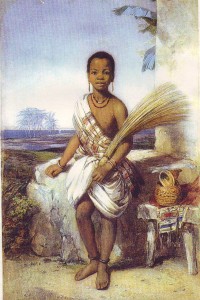Sarah Forbes Bonetta was brought to England from West Africa in 1850 where she was presented to Queen Victoria who financed her education and became godmother to her daughter Victoria, born 1863. Commander Forbes and his ship HMS Bonetta had their names honoured. Married to a West African merchant in Brighton, she died in 1880.
Her daughter married a Scotland-qualified doctor, the African John Randle. Living in London in the 1900s Mrs Victoria Davies Randle provided a Nigerian theme to Samuel Coleridge-Taylor who arranged it and published it in his Twenty-four Negro Melodies (Boston, MA: Ditson, 1905). Before Sarah Bonetta’s fame she posed for this water colour by Octavius Oakley, who was known as a painter of gypsies and personalities including Joseph Paxton. The painting went on sale in London in March 2000 priced at £7,500 when the catalogue subtitled it “the Dahoman Captive”.
My thanks to the late Christopher Fyfe
Another ship’s captain and the name of the ship are to be found in 19th century Brighton.
A youth aged about eight was rescued from a dhow off the coast of East Africa on 24 August 1866 by HMS Highflyer of the British anti-slavery patrol based in Zanzibar. The ship and the name of its Captain, Thomas Malcolm Sabine Pasley, were given to the African and as Tom he reached England. In 1870 he was living in Brighton where he died on 20 June 1870. His grave stone in memory of Tom M. S. Highflyer in Woodvale cemetery was noted by local black history devotee Bert Williams. The death registration has Thomas Malcolm S. Highflyer as his name from which we can guess that the “S” was for Sabine. “Rescued from a slave dhow August 24, 1866, baptised by his own request at Brighton March 30, 1870 died at Brighton June 20, 1870 supposed to be about 12 years old”. Captain Pasley died in Kendal earlier in 1870, aged 40. The connection with Brighton is not yet understood.
My thanks to Bert Williams of Brighton and Hove Black History.
SEE ALSO page 054 and page 261
LEAVE A RESPONSE IN THE ‘LEAVE A REPLY’ BOX AT THE END OF THIS PAGE.
